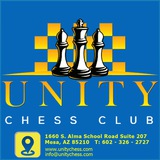More tenacious was 24.exd5, although after 24...e4 25.Nxe4 Bxb2, Black still has a large advantage.
24...Bxd5 25.exd5 Rxc2 26.b3 e4 27.g4 e3 28.Rg2 Rd2 29.Rxd2 exd2 30.Bd1 Rxd5
With rooks on the board, the opposite-coloured bishops are not such a drawing factor, and the realisation of Black’s advantage does not pose any great difficulties.
31.Kg1 Kf8 32.Kf1 Bg5 33.a4 h5 34.h3 h4 35.axb5 axb5 36.Rf2 Ke7 37.Rf3 Re5 38.Be2 Rd5 39.Bd1 Kf6 40.Rc3 Bf4 41.Ke2 Kg5 42.Rf3 b4 43.Kf1 Re5 44.Be2 Be3 45.Bd1 Kf6 46.Be2 Re4
Unity Chess Club
Miguel Najdorf Robert Fischer Santa Monica 1966 White to move
If Black could succeed in blockading e5, he would have an excellent game. However, it is White’s move, and he carries out a temporary pawn sacrifice, to open up play for his pieces on the light squares:
The black pieces are totally lacking mobility, whilst White’s cooperate excellently and control all the key squares.
Unity Chess Club
Lev Polugaevsky 2600 Tigran Petrosian 2605 Kislovodsk 1982 White to move
In such a structure, the black Be7 would be better on g7. In that case, his king would feel safer, and the breaks e4-e5 and f4-f5 would not be so terrible. White’s pieces are all pointing at the kingside and on the long diagonal, and the Bb2 has no opponent. Whilst Black has no time to organise himself properly, White attacks.
